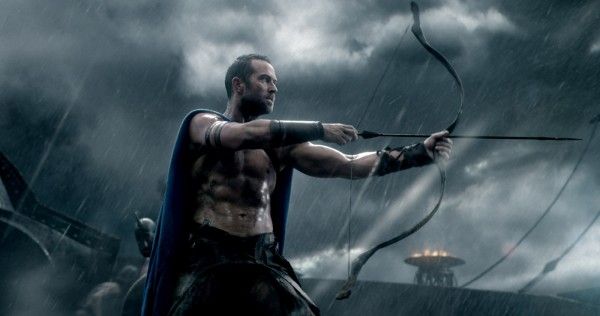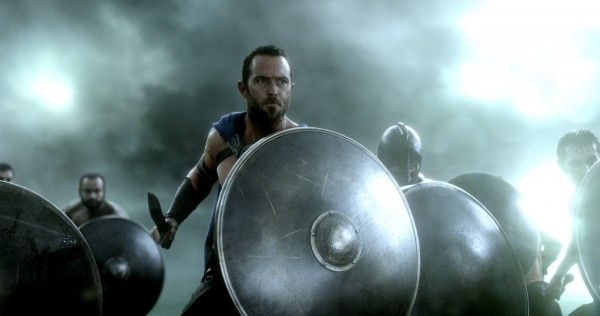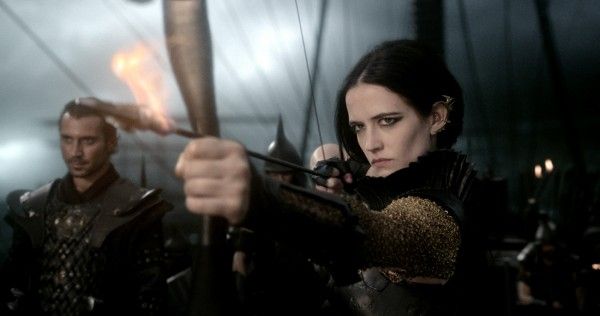When Zack Snyder’s 300 was released in 2007, it was a vibrant explosion of exhilarating bloodshed and goofy earnestness. Although its impact has been somewhat diminished by imitators and a more widespread reliance on predominantly CGI environments, it’s still a memorable picture, and providing a sequel isn’t completely unwarranted. However, 300: Rise of an Empire has trouble expanding beyond “300 with boats”, and while it’s still packed with fun kills and a similar tone, some of the key elements are missing, and all it really has to add to the mix is a delightful performance from Eva Green.
300: Rise of an Empire is a prequel, side-story, and sequel to 300. It begins by explaining the origins of the “god king” Xerxes (Rodrigo Santoro), how his father King Darius (Igal Naor) was felled by an arrow fired by the Athenian hero Themistokles (Sullivan Stapleton), and Xerxes’ plans to take revenge on Greece with the help of his ruthless general Artemisia (Green). Unlike the Spartans, the Athenians are skilled sailors, and most of the action takes place at sea as Themistokles and Artemisia battle across the sea, and we occasionally cut to moments from 300 to get a concept of the timeline.
Director Noam Murro faces two major disadvantages in his adaptation. First, he has to follow Snyder, and 300 was his breakout film. The original grossed over $450 million worldwide, and so it brings heavy expectations for the sequel. But some people may not know how faithfully Snyder followed Frank Miller and Lynn Varley’s graphic novel. Murro has no graphic novel, so he tries to follow Snyder’s example with speed ramping and loads of CGI blood.
Unfortunately, he omits other elements that gave Snyder’s film its extra pop. While Snyder did have a blueprint, Murro doesn’t bring over the monsters or the other bizarre elements that peppered the original. The CGI blood is also diminished because even though the kills are brutal, the blood doesn’t pop against the grey, overcast backdrop where most of the movie takes place. It’s as if Murro is trying to create a movie that’s slightly more grounded, but he’s also obligated to play to the bombast established in the first film.
This ambivalence is also present in the characters of Themistokles and Artemisia. Stapleton has the rugged, leading man looks, but he lacks Butler’s charisma and personality. Butler made us believe that King Leonidas could command the respect of his men, and they would gladly follow him to a glorious death. Themistokles is the responsible adult in the room. He’s a leader because he killed Darius and tells the sailors what to do.
By comparison, Artemisia is terrifying, and Green has the screen presence to convince us that her character can force anyone into submission. What’s more remarkable about her performance is that she never chews the scenery. Green is clearly having a blast, but she also holds the picture’s ideal tempo—serious enough to captivate the audience, but not so po-faced as to drain out all the fun. She also has the benefit of some gorgeous costumes, which makes her even more colorful when contrasted against the Athenians uniform blue capes.
Pulled apart by its desire to be taken seriously and playing into the grandiosity from the original, Murro’s picture falls into a state of mediocrity. It wants to go its own direction into a movie that’s a little more serious and substantive (at least the Athenians can honestly proclaim a love of freedom whereas it rings hollow with the Spartans, who force parents to throw weak babies off a cliff), but it’s also a movie where a guy goes into a magic pool and emerges golden, pierced, and taller. It also sticks us with the bland Themistokles when we really want to spend more time with Artemisia. Torn in different directions, 300: Rise of an Empire is occasionally enjoyable, but ultimately lost at sea.
Rating: C+





